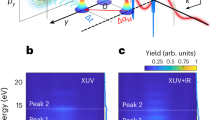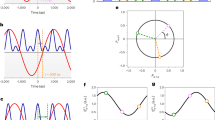Abstract
Currently, the shortest laser pulses1 that can be generated in the visible spectrum consist of fewer than two optical cycles (measured at the full-width at half-maximum of the pulse's envelope). The time variation of the electric field in such a pulse depends on the phase of the carrier frequency with respect to the envelope—the absolute phase. Because intense laser–matter interactions generally depend on the electric field of the pulse, the absolute phase is important for a number of nonlinear processes2,3,4,5,6,7,8. But clear evidence of absolute-phase effects has yet to be detected experimentally, largely because of the difficulty of stabilizing the absolute phase in powerful laser pulses. Here we use a technique that does not require phase stabilization to demonstrate experimentally the influence of the absolute phase of a short laser pulse on the emission of photoelectrons. Atoms are ionized by a short laser pulse, and the photoelectrons are recorded with two opposing detectors in a plane perpendicular to the laser beam. We detect an anticorrelation in the shot-to-shot analysis of the electron yield.
This is a preview of subscription content, access via your institution
Access options
Subscribe to this journal
Receive 51 print issues and online access
$199.00 per year
only $3.90 per issue
Buy this article
- Purchase on Springer Link
- Instant access to full article PDF
Prices may be subject to local taxes which are calculated during checkout



Similar content being viewed by others
References
Nisoli, M. et al. Compression of high-energy laser pulses below 5fs. Opt. Lett. 22, 522–524 (1997).
Brabec, T. & Krausz, F. Intense few-cycle laser fields: frontiers of nonlinear optics. Rev. Mod. Phys. 72, 545–591 (2000).
Krausz, F. From femtochemistry to attophysics. Phys. World 14, 41–46 (2001).
Rabitz, H., de Vivie-Riedle, R., Motzkus, M. & Kompa, K. Whither the future of controlling quantum phenomena? Science 288, 824–828 (2000).
Reichert, J. et al. Measuring the frequency of light with mode-locked lasers. Opt. Commun. 172, 59–68 (1999).
Jones, D. J. et al. Carrier-envelope phase control of femtosecond mode-locked lasers and direct optical frequency synthesis. Science 288, 635–639 (2000).
Apolonski, A. et al. Controlling the phase evolution of few-cycle light pulses. Phys. Rev. Lett. 85, 740–743 (2000).
Drescher, M. et al. X-ray pulses approaching the attosecond frontier. Science 291, 1923–1927 (2001).
Spielmann, Ch. et al. Generation of coherent X-rays in the water window using 5-femtosecond laser pulses. Science 278, 661–664 (1997).
Rundquist, A. et al. Phase-matched generation of coherent soft X-rays. Science 280, 1412–1415 (1998).
Paul, P. M. et al. Observation of a train of attosecond pulses from high harmonic generation. Science 292, 1689–1692 (2001).
Nisoli, M., De Silvestri, S. & Svelto, O. Generation of high energy 10 fs pulses by a new pulse compression technique. Appl. Phys. Lett. 68, 2793–2795 (1996).
Telle, H. R. et al. Carrier-envelope offset phase control: A novel concept for absolute optical frequency and ultrashort pulse generation. Appl. Phys. B 69, 327–332 (1999).
Eckstein, J. N. High-resolution Spectroscopy using Multiple Coherent Interactions. Thesis, Stanford Univ. (1978).
Wineland, D. J., Bergquist, J. C., Itano, W. M., Diedrich, F. & Weimer, C. S. in The Hydrogen Atom (eds Bassani, G. F., Inguscio, M. & Hänsch, T. W.) 123–133 (Springer, Berlin, 1989).
Durfee, Ch. G. et al. Phase matching of high-order harmonics in hollow waveguides. Phys. Rev. Lett. 83, 2187–2190 (1999).
Agostini, P., Fabre, F., Mainfray, G., Petite, G. & Rahman, N. Free-free transitions following six-photon ionization of xenon atoms. Phys. Rev. Lett. 42, 1127–1130 (1979).
Cormier, E. & Lambropoulos, P. Effect of the initial phase of the field in ionization by ultrashort laser pulses. Euro. Phys. J. D 2, 15–20 (1998).
Dietrich, P., Krausz, F. & Corkum, P. B. Determining the absolute carrier phase of a few-cycle laser pulse. Opt. Lett. 25, 16–18 (2000).
Christov, I. P. Phase-dependent ionization in the barrier suppression regime. J. Appl. Phys. B 70, 459–462 (2000).
de Bohan, A., Antoine, Ph., Milosevic, D. B. & Piraux, B. Phase-dependent harmonic emission with ultrashort laser pulses. Phys. Rev. Lett. 42, 1127–1130 (1979).
Potvliege, R. M., Kylstra, N. J. & Joachain, C. J. Photon emission by He+ in intense ultrashort laser pulses. J. Phys. B 33, L743–L748 (2000).
Press, W. P., Flannery, B. P., Teukolsky, S. A. & Vetterling, W. T. Numerical Recipes (Cambridge Univ. Press, Cambridge, 1986).
Acknowledgements
We thank A. Kasper, H. Stehbeck and K. Witte for their collaboration in the early stage of this project.
Author information
Authors and Affiliations
Corresponding author
Rights and permissions
About this article
Cite this article
Paulus, G., Grasbon, F., Walther, H. et al. Absolute-phase phenomena in photoionization with few-cycle laser pulses. Nature 414, 182–184 (2001). https://doi.org/10.1038/35102520
Received:
Accepted:
Issue Date:
DOI: https://doi.org/10.1038/35102520
This article is cited by
-
Ionization of hydrogen atom driven by ultrashort intense laser pulses: study in momentum space of phase-dependent effects
Indian Journal of Physics (2024)
-
Subcycle surface electron emission driven by strong-field terahertz waveforms
Nature Communications (2023)
-
Carrier-envelope phase on-chip scanner and control of laser beams
Nature Communications (2023)
-
Light phase detection with on-chip petahertz electronic networks
Nature Communications (2020)
-
Vanishing carrier-envelope-phase-sensitive response in optical-field photoemission from plasmonic nanoantennas
Nature Physics (2019)
Comments
By submitting a comment you agree to abide by our Terms and Community Guidelines. If you find something abusive or that does not comply with our terms or guidelines please flag it as inappropriate.



